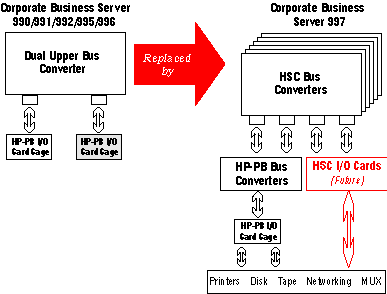New I/O channel promises extra 3000 connections, speed
High Speed Connect bus brings Fiber Channel to MPE/iX for peripherals
HP 3000 connectivity gets an overhaul in the upcoming release of
the new Series
997 servers with the addition of the first High Speed Connect (HSC) cards
for HP 3000s.
HSC is essential to bringing Fiber Channel connectivity to MPE/iX, but it
also delivers
more capacity for disk drives already in use with HP 3000s.
The new interface is important because it's the most distinguishing
feature
between existing HP's high end HP 3000s and the new Series 997 systems.
Those new
997s, which HP will ship in the third quarter of 1997, use the same
processor as the
Series 979 midrange systems that first shipped last year.
The Series 997s do use a faster processor than their Series 996 and 995
predecessors, but the HSC distinction is the most significant new
technology HP is
introducing. HP says when customers are deciding whether to upgrade their
systems to
either 996s or 997s, connectivity should be one of the major factors in the
choice. The
move to HSC means there can be 12 HP-PB I/O channels on a single HP 3000
system,
delivering up to 168 interfaces where there were only 112 before.
The Series 996 systems will continue to use HP Precision Bus (HP-PB)
connections through a Dual Upper Bus Converter. HP is replacing that
component in the
Series 997 with a new HP-HSC Bus Converter, which accepts as many as two
HP-PB Bus
Converters. These converters accept HP-PB I/O card cages (see figure below).
 Upgrades between Series 996 and 995 systems and the new 997s will require
customers to replace their Dual Upper Bus Converter with the new HP-HSC Bus
Converter. HP is providing the first HSC Converter as part of the upgrade
cost between
systems, but second through sixth converters will be additional cost items
($5,500 each)
in the upgrade. HP-PB Bus converters are $1,000 each. All existing HP-PB
I/O cards can
be used in the new HSC configurations.
Upgrades between Series 996 and 995 systems and the new 997s will require
customers to replace their Dual Upper Bus Converter with the new HP-HSC Bus
Converter. HP is providing the first HSC Converter as part of the upgrade
cost between
systems, but second through sixth converters will be additional cost items
($5,500 each)
in the upgrade. HP-PB Bus converters are $1,000 each. All existing HP-PB
I/O cards can
be used in the new HSC configurations.
The most significant impact of the 3000's move to HSC might be its new
peripheral bandwidth. HSC, when used without any HP-PB Bus Converters,
provides a
pathway to the faster links like Fiber Channel and ATM through HSC I/O
cards. HP told
customers in an IPROF briefing this spring that Fiber Channel is the future
of 3000
peripheral connectivity. A look at this spring's release of new HP
peripherals in another
part of HP's computer business shows why.
HP recently rolled out its first family of Fiber Channel devices
encompassing an
FC-AL (Fiber-Channel Arbitrated Loop) hub as well as the first Fiber
Channel connection
for EMC's Symmetrix 3000 storage device. The devices are being first
deployed in a new
Model 30/FC High Availability Disk Array for HP 9000s. The array will
support the new
FC-AL hub, with up to 17 disk arrays per single FC loop. That loop operates
at 100
megabytes per second, a serious increase over the current 32 megabytes per
second of
SCSI connectivity.
CSY Product Manager Dave Snow said that while ATM capability is still
in the
future for the HP 3000, Fiber Channel work is already underway. HP is
promising a
1998 release of the technology for MPE/iX. "We actually have some active
development
going on for Fiber Channel," he said. "The ATM is still in investigation
phase."
Copyright 1997, The 3000 NewsWire. All rights reserved.
 Upgrades between Series 996 and 995 systems and the new 997s will require
customers to replace their Dual Upper Bus Converter with the new HP-HSC Bus
Converter. HP is providing the first HSC Converter as part of the upgrade
cost between
systems, but second through sixth converters will be additional cost items
($5,500 each)
in the upgrade. HP-PB Bus converters are $1,000 each. All existing HP-PB
I/O cards can
be used in the new HSC configurations.
Upgrades between Series 996 and 995 systems and the new 997s will require
customers to replace their Dual Upper Bus Converter with the new HP-HSC Bus
Converter. HP is providing the first HSC Converter as part of the upgrade
cost between
systems, but second through sixth converters will be additional cost items
($5,500 each)
in the upgrade. HP-PB Bus converters are $1,000 each. All existing HP-PB
I/O cards can
be used in the new HSC configurations.